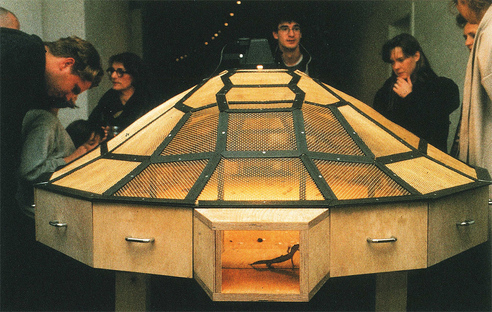
R
E
V N
E
X
T
The forthcoming “Art and China After 1989: Theater of the World” exhibition at the Solomon R. Guggenheim Museum in New York, which was to feature over 150 works of conceptual and experimental art created after the end of the Cold War to explore the subsequent spread of globalization and the rise of China, has become a subject of controversy with its planned inclusion of live animals in three of its artworks.
Huang Yongping’s Theater of the World (1993), which lends its name to the show, involves live lizards, toads, snakes and insects placed under warming lamps in a structure of wood and metal mesh; the creatures in this work are meant to eat each other in an ecosystem designed by the artist. Sun Yuan and Peng Yu’s seven-minute video Dogs That Cannot Touch Each Other (2003) documents a performance that featured four pairs of pit bulls in harnesses, running toward each other on treadmills but prevented from ever making contact. (Contrary to some reports, there was no fighting during the original performance.) Xu Bing’s A Case Study of Transference (1994) involved a boar and a sow whose skin was stamped with text, and then were placed in a pen inside a Beijing museum.
A petition on Change.org calling for the removal of these works from the exhibition has garnered over 545,000 signatures (out of the goal of 1 million) at the time of this writing. Its author claims that “the exhibit will feature several distinct instances of unmistakable cruelty against animals in the name of art.” The same petition later states: “Let [the museum] know that animal cruelty holds no place in art in the United States.”
The Guggenheim has indicated that its staff has worked with an entomologist as well as reptile and insect care experts. In the same statement, the museum pointed out that the insects were “sourced in consultation with local experts and in accordance with New York State regulations,” and that the reptiles have been “selected and are cared for by trained professionals, including regular observation by a veterinarian.”
“Art and China After 1989” is set to open on October 6, 2017. With less than two weeks until the show kicks off, the Guggenheim has decided against showing the three artworks in question, citing that “explicit and repeated threats of violence have made [the] decision necessary.” In the past, these artworks have been shown in museum presentations in Asia, Europe and the United States.
Brady Ng is the reviews editor of ArtAsiaPacific.
To read more of ArtAsiaPacific’s articles, visit our Digital Library.



